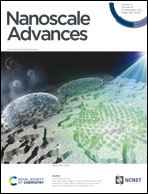Bi2O2Se-based integrated multifunctional optoelectronics†
Abstract
The prominent light–matter interaction in 2D materials has become a pivotal research area that involves either an archetypal study of inherent mechanisms to explore such interactions or specific applications to assess the efficacy of such novel phenomena. With scientifically controlled light–matter interactions, various applications have been developed. Here, we report four diverse applications on a single structure utilizing the efficient photoresponse of Bi2O2Se with precisely tuned multiple optical wavelengths. First, the Bi2O2Se-based device performs the function of optoelectronic memory using UV (λ = 365 nm, 1.1 mW cm−2) for the write-in process with SiO2 as the charge trapping medium followed by a +1 V bias for read-out. Second, associative learning is mimicked with wavelengths of 525 nm and 635 nm. Third, using similar optical inputs, functions of logic gates “AND”, “OR”, “NAND”, and “NOR” are realized with response current and resistance as outputs. Fourth is the demonstration of a 4 bit binary to the decimal converter using wavelengths of 740 nm (LSB), 595 nm, 490 nm, and 385 nm (MSB) as binary inputs and output response current regarded as equivalent decimal output. Our demonstration is a paradigm for Bi2O2Se-based devices to be an integral part of future advanced multifunctional electronic systems.



 Please wait while we load your content...
Please wait while we load your content...